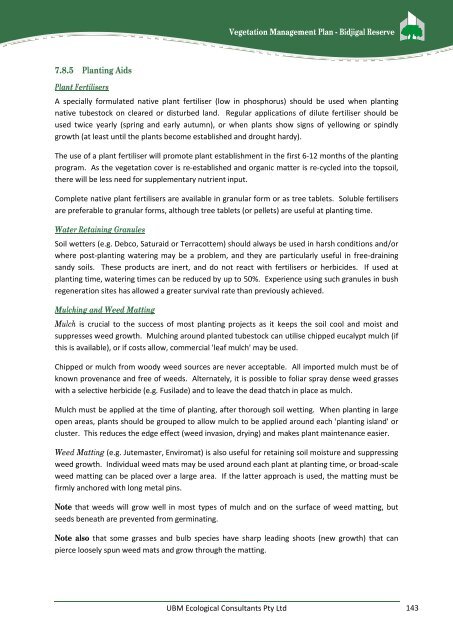VEGETATION MANAGEMENT PLAN for Bidjigal Reserve - Land
VEGETATION MANAGEMENT PLAN for Bidjigal Reserve - Land
VEGETATION MANAGEMENT PLAN for Bidjigal Reserve - Land
You also want an ePaper? Increase the reach of your titles
YUMPU automatically turns print PDFs into web optimized ePapers that Google loves.
Vegetation Management Plan - <strong>Bidjigal</strong> <strong>Reserve</strong>7.8.5 Planting AidsPlant FertilisersA specially <strong>for</strong>mulated native plant fertiliser (low in phosphorus) should be used when plantingnative tubestock on cleared or disturbed land. Regular applications of dilute fertiliser should beused twice yearly (spring and early autumn), or when plants show signs of yellowing or spindlygrowth (at least until the plants become established and drought hardy).The use of a plant fertiliser will promote plant establishment in the first 6-12 months of the plantingprogram. As the vegetation cover is re-established and organic matter is re-cycled into the topsoil,there will be less need <strong>for</strong> supplementary nutrient input.Complete native plant fertilisers are available in granular <strong>for</strong>m or as tree tablets. Soluble fertilisersare preferable to granular <strong>for</strong>ms, although tree tablets (or pellets) are useful at planting time.Water Retaining GranulesSoil wetters (e.g. Debco, Saturaid or Terracottem) should always be used in harsh conditions and/orwhere post-planting watering may be a problem, and they are particularly useful in free-drainingsandy soils. These products are inert, and do not react with fertilisers or herbicides. If used atplanting time, watering times can be reduced by up to 50%. Experience using such granules in bushregeneration sites has allowed a greater survival rate than previously achieved.Mulching and Weed MattingMulch is crucial to the success of most planting projects as it keeps the soil cool and moist andsuppresses weed growth. Mulching around planted tubestock can utilise chipped eucalypt mulch (ifthis is available), or if costs allow, commercial 'leaf mulch' may be used.Chipped or mulch from woody weed sources are never acceptable. All imported mulch must be ofknown provenance and free of weeds. Alternately, it is possible to foliar spray dense weed grasseswith a selective herbicide (e.g. Fusilade) and to leave the dead thatch in place as mulch.Mulch must be applied at the time of planting, after thorough soil wetting. When planting in largeopen areas, plants should be grouped to allow mulch to be applied around each 'planting island' orcluster. This reduces the edge effect (weed invasion, drying) and makes plant maintenance easier.Weed Matting (e.g. Jutemaster, Enviromat) is also useful <strong>for</strong> retaining soil moisture and suppressingweed growth. Individual weed mats may be used around each plant at planting time, or broad-scaleweed matting can be placed over a large area. If the latter approach is used, the matting must befirmly anchored with long metal pins.Note that weeds will grow well in most types of mulch and on the surface of weed matting, butseeds beneath are prevented from germinating.Note also that some grasses and bulb species have sharp leading shoots (new growth) that canpierce loosely spun weed mats and grow through the matting.UBM Ecological Consultants Pty Ltd 143
















